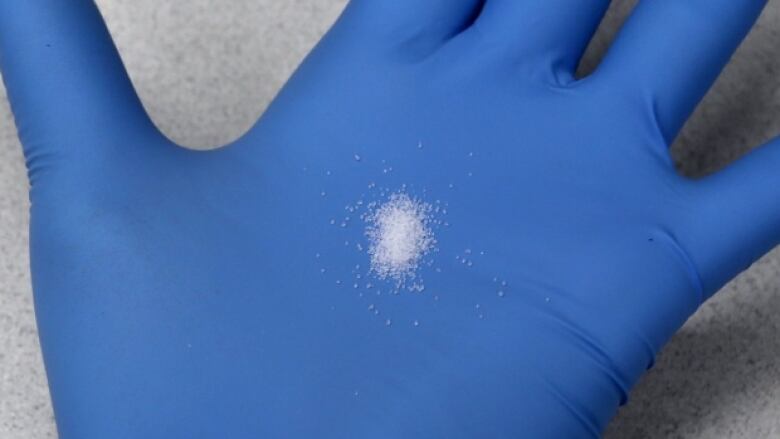Hamilton paramedics using Ebola masks to protect themselves from carfentanil
Paramedics pull out the highly protective masks they had on hand for possible Ebola exposure

After the Ebola threat passed, local paramedics stopped carrying their most intense mask for face and breathing protection in their vehicles.
But in the last week or so, ambulances in Hamilton are stocked once more with the P-100 masks.
They're preparing for exposure to carfentanil, a deadly synthetic drug 10,000 times stronger than heroin. The drug ismeant to beused as an animaltranquilizerand is sometimes cut in to counterfeit pills that look like other drugs.
That means some users or a family member or friend calling 9-1-1 may not know they took it.
But carfentanil's extreme potency means it could affect anyone who is exposed to it through their skin or inhalation. And so, there are risks to first responders, paramedics and anyone who encounters even tiny amounts of the drug in the air or on clothing.
'We don't know what it is when we get there'
Police announced last week that carfentanil had been found in Hamilton, but there have been no cases of people suffering overdoses linked to carfentanil. The Ontario Association of Chiefs of Police held a special training session in November based on huge demand from frontline officers wanting to know about the dangers of the drug.

"[The call] comes in as an overdose, or the patient is vital-signs-absent, or comatose, and the dispatcher really can't tell whether it's a carfentanil or fentanyl overdose," he said. "It's almost impossible for us to know."
In the absence of knowing, paramedics are given the option of that mask based on what they encounter at the scene.
It's just one of the additional precautions that paramedics, front-line workers in Hamilton shelters, police and other first responders are taking around carfentanil.
'Hidden in other drugs'
Hospital emergency staff have already been preparing to treat patients who may be exposed to the drug. Emergency room staff have been directed to wear face shields, masks, double gloves and a gown when interacting with a patient suspected of usingcarfentanil.

Public health workers are wearing gloves, masks and gowns when administering CPR or responding to an overdose. Naloxonekits are unlikely to be powerful enough to combat the effects ofcarfentanil.
"The presence of carfentanil is very concerning because it can lead to more overdoses and fatal overdoses," said Aisling Higgins, a spokesperson for city public health. "Carfentanil is 100 times stronger than fentanyl and is hidden in other drugs."
Police may wait to have direct contact with someone overdosing until they have protective equipment available in suspected overdoses involving the toxic substances, said Const. Stephen Welton.
"In general, when dealing with unknown substances such as carfentanil or any other believed dangerous drug, it is wise to make the assumption that the material or substance is extremely dangerous," Welton said.
"It's not like the drug dealers are labelling their illegal narcotics to make it easy for the police or first responders doing their part to respond to incidents when they do unfortunately emerge in our community."
'You have to err on the side of caution'
In the community, some frontline shelter and public health staff are instituting similar defenses.
Workers at shelters like Mission Services men's shelter at the corner of James and Barton streets have been trained to use naloxone, or Narcan, kits to counteract the effects of opioid overdoses.

But the presence of carfentanil in Hamilton is raising the alert level. Naloxone may not be effective in combatting carfentanil. And even tiny amounts of the drug on a user's clothing could affect the worker trying to administer help.
"We try to stay mindful and cognizant of the fact that carfentanil is not your traditional opiate, not your traditional drug," said Shawn MacKiegan, who oversees the shelter for Mission Services. "The precautions are different."
Naloxone kits distributed free at pharmacies already typically contain disinfectant, gloves, a mask, naloxone and syringes, plus information on responding to an overdose.
The staff at Mission Services men's shelter have used naloxone kits twice before, and are now prepared to wear double gloves and a mask if they encounter another suspected opiate overdose, MacKiegan said.
"You have to err on the side of caution," MacKiegan said. "You have to be prepared for the unknown."
Precautions for users and families
City of Hamilton public health officials also are warning families and drug users about the risks of leaving substances around households where others may come into contact.
And paramedics say people administering naloxoneshould make sure the person is breathing and has a clear airway, not just administering the antidote.
Public health officials issued some other precautions for drug users and families:
- Don't use drugs alone, use a smaller dose or don't inject the whole dose at once.
- Don't leave substances on surfaces where others in the household can come in contact.
- Get a naloxone kit and training by calling theHamilton Overdose Prevention Education(HOPE) program at905-546-4276or1 (800) 565-8603
- Always call 9-1-1 after an overdose. Naloxone should not be expected to be effective due to the high potency ofcarfentanil.












_(720p).jpg)


 OFFICIAL HD MUSIC VIDEO.jpg)
.jpg)



























































































